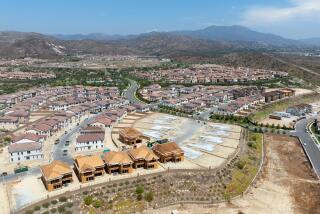Buffalo Shuffle Off : Remaining Bison at Old Irvine Theme Park Site Sold to Make Way for Road Realignment
- Share via
IRVINE — His name is Happy and he’s a 1,600-pound American bison. On Sunday, he was chomping on alfalfa strands while an auctioneer’s rapid-fire cadences pierced the air here.
The auctioneer, standing on a bale of hay, sang, “$2,000, $2,000, do I hear $2,100?”
Happy took a few more bites, then shook his head with such force that dried mud flew off his furry mane, creating a ring of dust around his head and horns.
When the auctioneer finally announced, “Sold for $2,000!” Happy and fellow bison Lucky and Rainbow were rolling in the muddy pasture, unaware that they had just been sold, unaware that a long tradition in Orange County had just ended.
To make way for the realignment of Ford Road, the remaining buffalo at the Buffalo Ranch, a defunct 1950s theme park that has been an office complex for years, were sold by owner William Lange with all proceeds going to local charities.
John R. Cogorno, a Westminster criminal defense attorney and part-time rancher, bought the burly bison for his 10-acre ranch in Lancaster. Cogorno said he is fulfilling a dream to own a true American original and to start his own herd of buffalo.
“I’ve always loved the West and am happy to be buying and preserving a part of it,” Cogorno, 48, said. He said he wants to breed the animals, then move them to a larger ranch in Wyoming.
The sale of Happy, Lucky and Rainbow ends the long role in local history buffalo have played at MacArthur Boulevard and Ford Road.
In the mid-1950s, innovative entrepreneur Gene Clark imported 100 bison from Kansas and released the herd onto 100 acres of the hilly terrain he rented from the Irvine Co.
Hoping to create one of Orange County’s first theme parks, Clark added a kiddie train ride on the property, set up an Indian village, kept livestock in a barn and sold buffalo burgers and handicrafts from his newly named “Buffalo Ranch.” People paid per carload to drive across a winding road on the property in a Lion Country Safari-type experience.
Newport Beach Historical Society President Bill Grundy, 70, remembers taking a carful of kids through the ranch when it was in its prime.
“We had a Ford convertible at the time, and I remember once there was a big bull on one side and the herd on the other. I drove in the middle and the bull got so close to the car, I could see it frothing. I said, ‘Look, kids,’ but they were on the floorboard, hiding behind the seats,” Grundy said.
The Buffalo Ranch was short-lived. In a few years, all that remained was an empty red barn and adjoining silo. Clark sent all the buffalo back to Kansas.
The buildings sat unused until architect William L. Pereira drove past the facility in 1960 while working on the master development plans for the city of Irvine.
Pereira, whose works included the Transamerica Building in San Francisco and Los Angeles International Airport, fell in love with the barn’s rustic charm and he moved in drafting tables to create a satellite office of William L. Pereira Associates. He later added several smaller barrack-style buildings to the site.
In 1983, Pereira sold the buildings to William Lange, who has since headquartered his real estate business at the site.
Five years later, Lange brought two buffalo from Colorado to a corral behind the five-acre property to revive the buffalo’s heritage at the site and to give his young children a taste of the country, Lange said.
The Irvine Co., which still owns the land, will not extend Lange’s lease when it expires this month. Instead, Lange is moving his offices to a newer building in Newport Beach, and the land will be used for the realignment of Ford Road, which will eventually connect with the 15-mile San Joaquin Transportation Corridor.
The red ranch-style buildings have been designated as historic structures and are protected from demolition. An Irvine Co. spokeswoman said the firm is still deciding what to do with the land.
When he decided to sell the buffalo, Lange wanted to make sure the animals would be kept alive. To qualify, bidders first had to guarantee that no bison would be slaughtered.
“I would’ve taken $500, if it was the only bid which I knew for sure the bison would be taken care of,” Lange said.
Cogorno said he would never consider entering the lucrative buffalo meat market. “I can’t imagine killing something so beautiful, so American,” he said.
More to Read
Sign up for Essential California
The most important California stories and recommendations in your inbox every morning.
You may occasionally receive promotional content from the Los Angeles Times.













